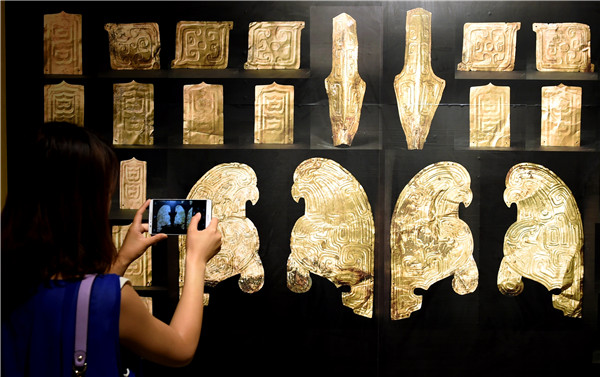
A visitor photographs ornamental gold foil at the Gansu Provincial Museum in Lanzhou, capital of Gansu province, on Monday. The exhibits, which date back more than 2,000 years, have been recently retrieved from France after being stolen and sold overseas in the 1990s. [Photo by Fan Peishen/Xinhua]
After more than two decades overseas, newly returned Chinese treasures were welcomed home with a special exhibition in Lanzhou, Gansu province, on Monday.
The 32 glittering pieces of ornamental gold foil from the Qin State of the Spring and Autumn Period (770-476 BC) went on display in the Gansu Provincial Museum to celebrate their return from France.
Song Xinchao, deputy director of the State Administration of Cultural Heritage, said the pieces of gold foil were among the large number of relics illegally excavated between 1990 and 1993 from the Dabuzi Hill tomb complex in Lixian county, Gansu province.
The free exhibition, The Charm of Qin: Gems of Cultural Relics Unearthed in Dabuzi Hill, includes 109 other pieces from the Gansu Provincial Museum and other local archaeological institutions. It runs until Oct 31.
The 32 pieces of foil were held by two French antique collectors, Francois Pinault and Christian Deydier, and were later donated to the Guimet Museum in Paris.
Chinese cultural heritage authorities began seeking their return in 2005, and they reached an agreement with their French counterpartsthis year after long negotiations.
Pinault transferred his donation to the State Administration of Cultural Heritage in April, and Deydier took his collections to China in May.
Li Xiaojie, director of the State Administration of Cultural Heritage, said the return showed the determination of two culturally resourceful countries to take responsibility and build an international framework to protect cultural heritage.
Maurice Gourdault-Montagne, French ambassador to China, said, "Cultural exchange is always an important cornerstone of communication between two countries".
"Thanks to the private collectors' moves, local people are able to see their own treasures in their homeland," he said.
Song said that the lack of direct evidence was another hurdle to repatriating the lost treasures. A major archaeological project at Dabuzi Hill has created a solid foundation for comparative academic research, he said.
Wang Hui, head of the Gansu Provincial Institute of Archaeology, said, "We cooperated with the French to compare the 32 pieces with what our archaeological team unearthed in Dabuzi Hill through comprehensive analysis, including metal components, soil samples and their artistic styles, and finally proved they shared the same birthplace".
Song said there are still other relics from Dabuzi Hill in private collectors' hands.
"Most collectors didn't know that these lost treasures were illicitly expatriated when they bought them," Song said. "So we don't expect them to immediately return their collections back to China. However, we hope they will at least keep the pieces in their hands rather than transfer them somewhere else."
Local villagers first found bronze vessels at Dabuzi Hill in the late 1980s, and about 10,000 people participated in tomb robbery at its peak.
Though the thefts almost ended after a three-year police campaign starting in 1994, Song said Dabuzi Hill remains one of China's two most seriously raided high-level tomb complexes from the Spring and Autumn Period.
While some domestic collectors are willing to buy lost Chinese relics and bring them back home from overseas, Song did not consider that the best solution.
"We don't encourage paying high prices to purchase lost national treasures, which were taken abroad through unusual means in the first place. Diplomatic and legal channels should be used more."
Academics wrestle with history
The Qin Dynasty (221-206 BC), China's first unified imperial dynasty, was built after the Qin State conquered six major vassal states.
However, historians' understanding of the origin of this power was ambiguous for a long time.
An area in what is now southeast Gansu province is in historical records as being where the Qin tribe was first formed.
But academics had conflicting ideas on the birthplace of the Qin rulers' ancestors until the 1980s, due to a lack of important archaeological discoveries to prove the theory.
Wang Hui, head of the Gansu Provincial Institute of Archaeology, said the Dabuzi Hill Relics provided an important clue to solving the historical mystery because they unearthed ancient family tombs, cemeteries and sacrificial sites.
"Although tomb robbery had caused great harm to the relics, we were still able to find a relatively complete city layout," he said.
"It proved to be where the Qin tribe first raised horses, fought against other tribes from the west and gradually expanded to a wider area."
A large set of bronze bells unearthed on Dabuzi Hill in 2006 proved there was a highly developed civilization there. The bells were chosen among China's top 10 archaeological discoveries that year.
An archaeological project is still being carried out in the Dabuzi Hill area.
Wang said the pieces that were found represent typical Qin style, since some are bird-shaped and a bird was the totem of the Qin tribe. They were used as coffin decorations and armor for war horses.
Wang also said gold ornaments that were found were unique to Dabuzi Hill compared with archaeological relics from the same historical period.
"Other vassal states hardly used gold decorations because they originally came to China from Central Asia. ...
"Although the Silk Road is generally considered by academics to have started in the second century BC, interaction between China and other civilizations along that cultural communication route is thus proved to have been much earlier."